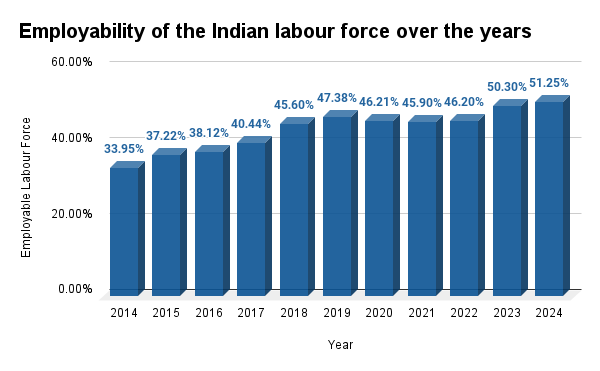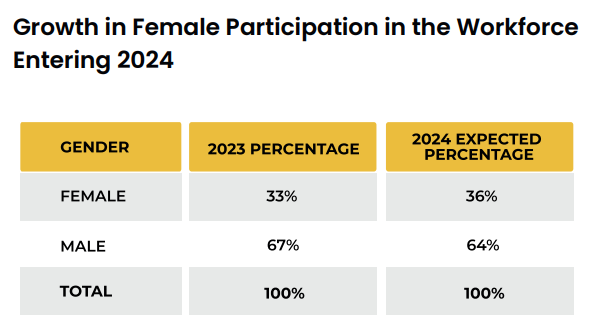-
CENTRES
Progammes & Centres
Location
The Indian service sector necessitates the implementation of specific policies to guarantee the adoption of technology and upskilling to secure growth

The latest estimates of Gross Domestic Product (GDP) released by the National Statistical Office (NSO) of India reveal that services reserve the greatest share of domestic output. The reliance on services for economic growth demands a fully developed job market, enabling a free flow of workers and a fair determination of wages. The absence of such mechanisms will lead to rigidity in the services sector, curtailing growth and imposing an economic penalty on the working class. This essay explores some crucial aspects of the current structure of the Indian job market, against the backdrop of the increasingly important position of the services sector. The key focus areas include the role of technology in shaping the services sector, the skill mismatches in the Indian labour market and the usage of services as the gateway to a gender-neutral work environment.
The reliance on services for economic growth demands a fully developed job market, enabling a free flow of workers and a fair determination of wages.
The momentous transformation of the Indian economy is being spearheaded by the service sector, which contributes more than 50 percent of the GDP. The sector's expansion is not happening in isolation but is deeply intertwined with global technological advancements. Technological progress has been a catalyst for efficiency, customer satisfaction, market expansion, and data-driven decision-making within firms. It has also given rise to new service categories, such as e-commerce and other tech-based services, revolutionising the sector.
The relationship between the service sector's growth and technological innovation is mutually beneficial. As the service sector expands, it fuels further innovation in technology-based solutions. New ventures and their technological needs push for continuous technological advancements to gain competitiveness that is needed to maintain their foothold in the dynamic industry. This competition and need for differentiation lead to increased investments in research and development (R&D) and open innovations, benefiting both the firms involved and the public.
Efforts to improve digital literacy have further accelerated technology adoption across India, with 69 percent of businesses identifying as “Digital Businesses” and the country exhibiting the highest fintech adoption rate at 87 percent.
The introduction of 5G and the ongoing development of 6G technologies have significantly enhanced connectivity, service delivery speed, and overall efficiency. Efforts to improve digital literacy have further accelerated technology adoption across India, with 69 percent of businesses identifying as “Digital Businesses” and the country exhibiting the highest fintech adoption rate at 87 percent. The application of Artificial Intelligence (AI) in business operations has improved operational efficiency, customer satisfaction, and decision-making, positioning India as a leader in AI adoption globally. However, the rapid digital transformation will require India to balance between creating employment and providing the relevant skillsets for technology-demanding jobs.
In India, the skill gap in the labour force is a significant challenge, with only about 51.25 percent of the youth deemed employable due to a lack of necessary skills. This issue is exacerbated by the country's diverse socio-economic conditions, particularly affecting those in rural areas and from economically disadvantaged backgrounds, who lack access to quality education and training. This situation not only perpetuates cycles of poverty but also aggravates wage inequality. The problem is further compounded by inadequate emphasis on developing non-technical skills such as communication, critical thinking, and leadership, which are increasingly in demand. The absence of these skills from the curriculum of most educational institutes stimulates employers to choose candidates only from a handful of premier institutes. Additionally, there is a significant mismatch between the skills taught and those required by employers, leading to unemployment even among the formally educated.
Figure 1: Employability of the Indian labour force over the years

Source: Compiled by authors from India Skills Report data (2022, 2024)
Efforts to bridge this gap should include public-private partnerships (PPPs), such as the initiative to upgrade Industrial Training Institutes (ITIs) and the establishment of the National Skill Development Corporation (NSDC) in 2009, aimed at training 150 million people by 2022. These initiatives represent steps toward aligning educational outcomes with market needs, emphasising the importance of both technical and non-technical skills development to enhance employability and address inequality within the Indian labour market.
Female employability in India has been consistently higher than male employability from 2020 to 2023 which has dropped in 2024. Furthermore, it has been higher for seven out of eleven years of the Wheebiz India Skills Report survey. However, there has been a persistent gap between female and male labour force participation, indicating a possible bias against employing women over men. Fortunately, this bias is diminishing as female labour force participation has risen over the years, but it still needs improvement.
The Indian government has implemented various initiatives to foster gender-inclusive employment, aiming to bridge the gender gap in the workplace, making employing female labourers more lucrative while also ensuring it does not come at the cost of pay disparity.
One significant legislation is the Equal Remuneration Act of 1976, designed to eliminate the wage gap between genders by ensuring equal pay for equal work. However, the act faces challenges, such as the narrow interpretation of “the same work or work of similar nature” and the onus on employees to prove discrimination, which is difficult due to workplace power dynamics and legal complexities.
One significant legislation is the Equal Remuneration Act of 1976, designed to eliminate the wage gap between genders by ensuring equal pay for equal work.
The Maternity Benefit (Amendment) Act of 2017 is another progressive step, extending paid maternity leave from 12 to 26 weeks and introducing provisions for work-from-home and creche facilities in larger establishments. The act hints at the potential for introducing paternity leave in the private sector, promoting shared childcare responsibilities, and supporting women's career advancement.
Additionally, the government has launched schemes like Mission Shakti and the DAY-NRLM scheme, focusing on women's skill development and employability. These initiatives include exclusive training institutes for women, industry-oriented courses, and partnerships with private sector bodies and NGOs. To encourage female participation in skill development, 30 percent of seats in ITIs and ITCs are reserved for women.
Table 1: Growth in female participation in the workforce entering 2024

Source: India Skills Report 2024
Political and defence force participation for women has been encouraged through reserved seats in legislative bodies and eased entry into government services. Financial inclusion initiatives and the promotion of women in executive roles are also crucial steps toward closing the gender gap, as greater female participation in decision-making and leadership positions has been linked to higher revenue and funding for businesses. These measures represent a comprehensive approach to promoting gender equality in employment, highlighting the importance of legislative support, skill development, and financial empowerment in achieving a more inclusive workforce.
The service sector is the key growth driver of the Indian economy, presenting both opportunities and challenges. Tackling these will require a multi-pronged approach with prudent policies and effective implementation. While PPPs and policies are there to address the issue of skill gaps, their implementation must be effective. Educational institutions should focus on updating their curriculum to meet the market’s skill demands.
To enjoy technological progress, educational institutions must ensure their curriculum is updated, and at par with the latest innovations.
Technological advancement has a catch, while fostering economic growth it necessitates continuous skill upgradation. To enjoy technological progress, educational institutions must ensure their curriculum is updated, and at par with the latest innovations. Further, gender parity is indispensable for holistic economic development. The legislations reflect the intent to remove gender imbalance, but there must be effective implementation. Empowerment via financial inclusion and leadership opportunities will unlock the potential growth of the economy. These steps will ensure that the potential of the Indian economy is fully harnessed, and the benefits are equitably distributed.
Arya Roy Bardhan is a Research Assistant at the Observer Research Foundation
Vedant Routh is a Research Intern at the Observer Research Foundation
The views expressed above belong to the author(s). ORF research and analyses now available on Telegram! Click here to access our curated content — blogs, longforms and interviews.

Arya Roy Bardhan is a Research Assistant at the Centre for New Economic Diplomacy, Observer Research Foundation. His research interests lie in the fields of ...
Read More +